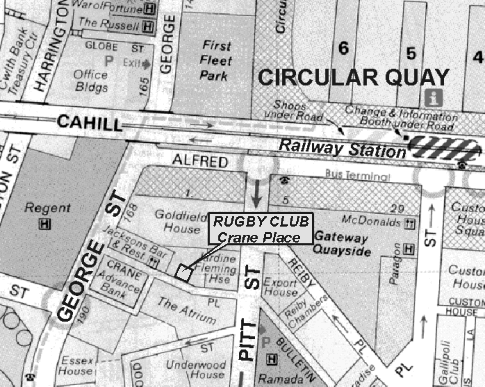
Rugby Club Location Map - Click to Enlarge
CONTROLS ON HIGH GRADE IN PORPHYRY Cu-Au STOCKWORKS
Gregg Morrison
Rugby Club - 5:30 p.m. Thursday, 29th January, 2004.
Stand-alone underground operations in porphyry Cu-Au systems generally require grades in excess of 2ECU (Cu % + Au ppm) and favourable mining conditions. This “high-grade’ may be achieved in the skarn (eg.DOM and DOZ at Grasberg) or in the high-sulfidation replacement (e.g.Lepanto) parts of these systems, or in associated epithermal veins(eg Victoria at Lepanto), but is rarely achieved in the vein stockworks that typify most systems.
In most stockworks it is the vein density and thickness that inhibit bulk grade rather than the grade of individual veins. In stockworks where high-grade is achieved, the distinctive feature is the confinement of veins to a narrow envelope or sheath in and around a spine-like intrusive body or structure. The vein confinement seems to be controlled by two main factors. Firstly, tough, generally hornfelsed wall rocks, which are not easily penetrated by over-pressured ore fluid, and secondly, the finger-like shape of the intrusive bodies, which are only able to transmit a limited amount of fluid-rich magma.
Within the mineralised part of the spines there is strong textural and paragenetic evidence for the transition between magmatic and hydrothermal conditions. The overall relationships suggest that ore can be derived from a single aliquot of fluid-rich magma by confinement near the intrusive carapace and rapid crystallisation caused by decompression. Multiple intrusive phases can increase or decrease the overall grade depending on which part of the ore sheath is superimposed on existing ore.
Most systems have multiple mineralised spines that are part of nested intrusive complexes. These complexes have potential for multiple high-grade ores as well as a variety of other mineralisation types that can make a long-life mining district. The biggest challenge to the exploration geologist in such complexes is to recognise the high-grade potential early on and then to predict and target it.
GREGG MORRISON is an exploration/research geologist with 30 years experience and a passion for ore controls in porphyry and epithermal systems. He was formerly the leader of 3 successful, AMIRA-funded projects on gold and magmatic-hydrothermal systems in eastern Australia, based out of James Cook University. He is currently a consulting geologist (Klondike Exploration Services,Townsville, Qld) working mainly in long term, mine exploration and advanced pre-mine projects.
Search for other Porphyry References on the SMEDG web site with FreeFind
|
Search this site
powered by FreeFind |
|
|

Rugby Club Location Map - Click to Enlarge